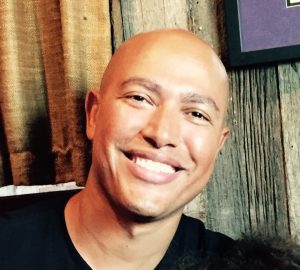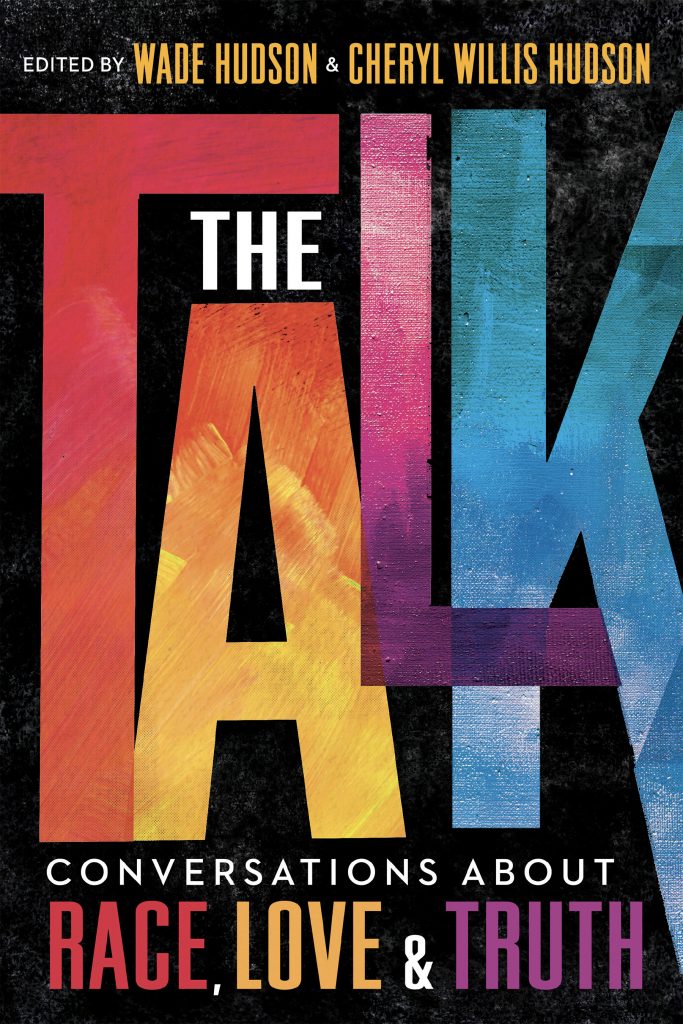
In The Talk, out today, thirty diverse, award-winning authors and illustrators engage young people in frank discussions about racism, identity and self-esteem. Featuring stories and images filled with love, acceptance, truth, peace, and an assurance that there can be hope for a better tomorrow, The Talk is an inspiring anthology and must-have resource published in partnership with Just Us Books, a Black-owned children’s publishing company that’s been in operation for over 30 years. Just Us Books continues its mission grounded in the same belief that helped launch the company:
Good books make a difference.
Today, we’re thrilled to welcome contributor Torrey Maldonado, the author of the critically acclaimed What Lane?, Tight, and Secret Saturdays. Torrey is a teacher in Brooklyn, New York, where he was born and raised. In The Talk, he shares a letter to his daughter.
How did your piece for The Talk come together?
Confession: my getting inspired is a BIG start to my writing-process. I get an idea, write it out, then it moves to an editor. With The Talk, the inspiration didn’t start with me. Cheryl and Wade told me they were editing an anthology and had ideas for what I might include. Immediately, I felt different things. First, I sort of became a guy version of Renée Zellweger in Jerry Maguire when she says, “You had me at . . .” because Cheryl and Wade had me at, “We wonder if you’d . . .” Secondly, I felt I was in a movie when a boss whispers, “I’ll make you an offer you can’t refuse”. I’m joking, but, for real though, if Cheryl and Wade ask, I don’t refuse because they see “the big picture” and it’s always brilliant. Also, whatever they publish serves children’s and our world’s best interests. So I agreed, then the anxiety of someone who dives into waters maybe too deep freaked me out a bit. How am I going to write what they want me to do? I worried. I reminded myself, Cheryl and Wade always see ‘the big picture’ and it’s always brilliant.
What they wanted were stories they heard me share of how my mom, sisters, and community help me rise. They felt those would help young people rise. So, I trusted them, sat to write, and soon an idea to tie it all together came to me: connect communal wisdom to young people today. The result? Like Common raps in the Glory song, my piece for The Talk “takes the wisdom of the elders and young people’s energy” in the form of a legacy-letter to my tween daughter to help her, all children, and our society rise.

You wrote about the ways that your mom offered “lasting rescues.” Can you talk a bit about the ways she used the power of story to nurture and sustain you?
In the Red Hook projects of Brooklyn, NY, where I was born and raised, schools and books killed the love of storytelling in kids. Schools and books didn’t let us see ourselves and didn’t encourage our affinity to storytell outside of the white canon’s constricting norms. My mom did the opposite–she encouraged any form of storytelling that powered me up. One medium was Hip Hop, especially since its characters resembled me, my friends, and our families. It was part of my world. Hip Hop was invented in my hometown of New York City when I was a tween and I remember when the rapper Biz Markie walked into my apartment. My sister and him dated. My love of stories wasn’t confined to Hip Hop. I loved comics, Sci-Fi, fantasy and my mom didn’t confine me to one lane. Look at what that did. It inspired me to teach to use my classroom and now my books to nurture and sustain the power of story in young people. I always say it, “My mom is my favorite teacher”.
Lyrics are peppered throughout your piece, and I know they are a natural part of your style of storytelling, in person and on the page. What are the connections you see between hip hop and the writing that you do for children?
I appreciate you, Cheryl, and Wade for embracing that part of me. The wrong people make what’s right about us seem wrong. Dr. Joe Dispenza says, “Your personality creates your personal reality”. The flip is true too: our personal reality creates our personality. Music and media shaped my childhood personal reality so they’re in my personality. I’ve had interviewers try to squish me into a different mold–their reality–by asking me to name only books that shaped my writing. That denies who I am. It almost just happened. In a recent chat, I was asked to pair my books with others. “Speak from the heart” I thought then said, “Books didn’t inspire me as much as Hip Hop and Rap. Can I pair Rap songs?” Thank goodness they agreed.
These Hamilton songs pair well with my books: Wrote My Way Out, My Shot, and The World Turned Upside Down. My books shows kids themselves, gives them images of them thriving, and helps them rise up, write their way out, and take their shot when their world is turned upside down. Jacqueline Woodson—our National Book Award-winning author of Brown Girl Dreaming—loved and blurbed Tight. In it, the protagonist is in tight situations and becomes his own type of hero. That’s My Shot. Jackie also listed my most recent book—What Lane?—in Oprah magazine as an essential antiracist book to help kids discuss race and what we see now. That’s The World Turned Upside Down. Secret Saturdays has two main characters who pen unspoken feelings and thoughts in private freestyle Rap books. That’s Wrote My Way Out.
You write about the damage that can be done to our children in the school system? How did you write your way out? How do you affirm your students’ experiences and support their creative lives in your classrooms? How has/will COVID-19 change your work as an educator?
Before our COVID-19 quarantine, I author-visited a private school and a fourth or fifth grader asked in the Q & A, “Is Tight your first or second book?” I replied, “Second”. She smiled, “It’s on our Mock Newbery list”. Wow! Those students were in a different lane of knowledge than I was from infancy to adulthood. They’re in a different lane than public middle schoolers where I’ve taught for over twenty years. In my school, ask ten random kids, “What’s a Newbery?” You’ll get ten shrugs. As a person, I ask myself, “How did I write my way out? How’d I end up where I am?” Then, as a teacher and author, I ask, “Do I support tweens where I’m from and who I teach to ride in the same lane as others?”
In third grade, I first dreamt of being a published author because of what my mom would do. We’d walk our poor Brooklyn projects and she told nearly anyone, “Torrey is a writer”. And our neighborhood replied by keeping me in that lane. From stoops: “Hey Torrey, when you writin’ me a book?” From corners: “Lil Man, when you readin’ me something you wrote?” That was a way the neighborhood supported me to be in the same lane as kids on the other side of the tracks who knew of Newberys. More instructional time has to be devoted to letting kids visualize, verbalize, and repeat their goals. “I’m going to be a writer,” stayed on-loop in my head as I grew up. That does a lot, including offsetting haters negating our dreams. Also, every kid can’t have my mother and “it takes a village to raise a child” so doing that routes kids toward a destination how my mom rerouted me. What she did drives me in school and writing.
My mindset in my efforts with students and young readers is I think of them and ask, “What Lane?” That’s why it’s my most recent title. Asking that question lets me support their lane, even if it’s a new route. COVID-19 has changed a lot for me as an educator. Now, the challenge is looking fancy for Remote Learning. I’m joking. I should get awarded a check on a talk show as a “Top Teacher” because I do dress up. I’m looking forward to what I’ll learn from my students because they can do amazing things with tech compared to me.
You wrote a letter to your daughter, Ava. What would you write to a young reader, today?
Here’s the thing: it was tough to write that letter! Now you’re asking me to write another one? LOL. I’m kidding. After I wrote the letter to Ava, I asked myself, “If I went back in time and gave this to my mother or one of my sisters or one of my brothers when they were tweens or teens, would it help them rise?” The answer: yes. Then I asked the next question “If I went into the future and gave this to my daughter’s tween or teen child, would it help them rise?” Again, the answer is yes. So I’m thrilled to get that letter into today’s young readers’ hands and see how it improves their lives.
What are some of your other favorite pieces in the collection? Why is this book necessary and why should it be in every classroom?
This isn’t an easy question. Answering it is as hard as being at a packed family holiday meal and the host-relative clinks an eating utensil against their glass cup and, once the noise lowers to where you can hear family breathe, the host asks, “Torrey, pick your favorite relatives in this room”. Here’s what I will say about The Talk: it’s a mosaic and each piece fits with the other and there’s such a mix of “talks” that there’s something for nearly every young reader and parent/caregiver/guardian. That’s why it’s needed in all homes and classrooms. There have been so many times when adults have said, “I wish I had the right words” and now they do. Just get The Talk and benefit from each contributor doing the hard work of putting essential lessons onto the page. Can I gush about one other aspect of The Talk? The amazing illustrations are added magic. Schools could create curricula and sensational art displays if they used the drawings.

Thank you so much, Torrey! Read his powerful letter and more in The Talk. Learn more about Torrey on his web site.
On social media:
Instagram: @torreymaldonado
Twitter: @torreymaldonado
Goodreads: torrey_maldonado

Thank you Torrey and thank you Cheryl and Wade! You spoke to your experience, unfiltered. Shout out to your mom, too! I love how she and your community validated and supported your decision to become a writer. Such an honor to learn how you “wrote your way out,” but stayed true to what’s within.